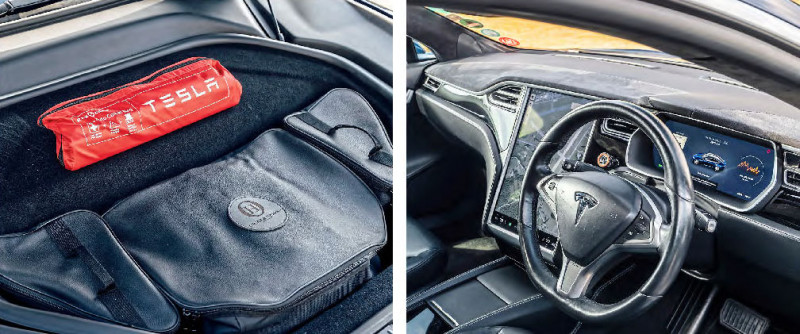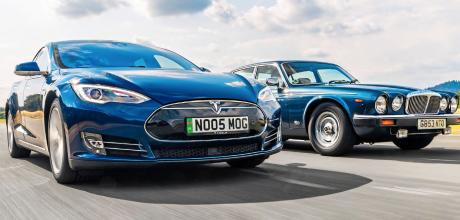2016 Tesla Model S P85D
Comparing the Daimler to a Tesla Model S might not seem to work at first, but both offer a quiet, refined and rapid drive. Sporting pretensions are clear from both machines, as is the aspirational nature of their respective brands. It seems unfathomable now, but less than a decade ago, Elon Musk was barely a household name. His first post-Paypal venture, SpaceX, had just completed its first successful rocket launch in September 2008 – the same year Tesla made its first car, the Roadster. Its success proved that battery technology had advanced to a point where it could compete with fossil fuels. Tesla was way ahead of the competition, further reinforced by Daimler AG’s $10-million investment in Tesla the following year.
With this and other substantial cash injections, Tesla developed a new model that would appeal to a broader audience. The Model S saloon was revealed to the public in 2011 and entered full-scale production at Tesla’s Fremont factory in California a year later. Widely praised by the press and early adopting owners alike, it was the firm’s first ground-up creation and one the rest of the motoring world thought was impossible.

This example is an 85D, an all-wheel-drive Model S with roughly 265-mile range. The tech in this thing is astonishing; in fact, it’s easier to describe it as a rolling technical showcase – traditionally the preserve of the Mercedes-Benz S-Class, though it’s certainly not put together as well. The major controls, like many modern cars, are all digital. Your feet push position sensors rather than linkages and the steering is electrically assisted, though both feel suitably weighty, and the steering weight is even customisable. Adaptive cruise control comes with lane assist, autopilot and emergency braking alongside a host of other apps and aids that we don’t have the space or inclination to list. But this isn’t a branch of Currys, it’s a car, so is it any good to drive or is it merely an extension of your smart phone?
Whirring off, once owner Justin gives me permission – literally, via the app on his phone – it’s apparent right away that this is one seriously capable machine. Its centre of mass is just inches from the Tarmac. The under-floor battery pack and twin AC motors result in 50/50 weight distribution. The result? A taut, well-balanced sensation to road manners at any speed, though its prodigious acceleration is what grabs my attention.
Ludicrous dispatch has been a Tesla crowd pleaser from the start and this Model S doesn’t disappoint. The surge when you bury the right pedal sticks you to the back of the seat like a bungee ride at a fairground. This isn’t even the fastest one. The 2017 Model S Plaid can see off the 60mph dash in a scarcely believable 1.99 seconds. In a drag race this all-wheel-drive Tesla has the traction, power and balance to really do some damage. That impression of composure from the chassis stands up to tough scrutiny when you’re pressing on in the corners too. Absolutely no dramas are caused by apexing swiftly, though there isn’t much from the steering to give you any indication of front tyre grip – a common complaint with most modern cars.
The loping or cumbersome direction changes I was expecting for a saloon weighing over two tonnes are almost completely absent, and marshalling the monumental torque delivery out of the bends is nothing to fear. As a performance saloon then, this thing makes an extremely good account of itself. As Tesla’s first ground-up design, it’s a remarkable achievement.
When you’ve finished driving like your hair’s on fire, the Model S settles down and it’s here where the comparisons to the Daimler begin to make a lot more sense. It’s eerily quiet, though the tyre, wind and motor noises are detectible, especially at higher speeds. Refinement is up there, but the Daimler trumps the Tesla for cabin opulence. The ride comparison is a much closer run thing, yet here the air-suspended American just nudges the old Coventry chariot.
There have been numerous reports of poor build quality, especially with older Teslas. Though it’s not as bad as some quarters of the internet would have you believe, you still need to keep check the history, and be sure any recall work has been carried out. These are biblically complicated machines but it’s mainly the peripheral tech that breaks, rather than the fundamental driveline bits.
Prices for the first-gen Model S have tumbled, as you’d expect for a near-decade-old design, though we were still surprised to see them hanging around the £35,000 mark. With 43% depreciation, that makes them a little better than for a contemporary ICE-powered product, before considering fuel savings. Though we’d still wince at the prospect of throwing away £40,000 in less than ten years, which is why buying one today makes so much more sense, you’re benefiting from someone else’s financial hit.
Owning a Tesla Model S
Justin Cockett has owned his P85D since new. ‘In 2013 Tesla opened a store at Westfield London, I was there. The team offered me a drive in a lhd Model S and I was completely blown away. I took delivery of mine in January 2016, so it’s now 6.5 years old with 147,000 miles. Because it was an early car, there were some initial build quality issues including minor blemishes, some chipping around one of the door handles, and a loudspeaker that wasn’t connected at the factory. I also had both headlights replaced under warranty because of water ingress. The car has never let me down. It costs very little to run because there are no oil, fuel or air filters in an EV and, because of regenerative braking, the car is still on its original brake disks and pads; impressive for a 2.2 tonne car!’
TECHNICAL DATA 2016 Tesla Model S P85D
- Engine Dual AC induction electric motors (one per axle) combined output 311kw
- Max Power 417bhp @ 5000-8000rpm
- Max Torque 485lb ft @ 0-5100rpm
- Steering Electric speed-sensitive rack and pinion
- Transmission One-speed automatic, all-wheel drive
- Suspension Front and rear: independent air suspended with adjustable ride height
- Brakes Front: vented Brembo discs with regenerative induction motor; Rear: solid Brembo discs with regenerative induction motor.
- Performance Top speed: 155mph;
- 0-60mph: 4.2sec
- Weight 2188kg
- Energy consumption 298Wh/mile
- Cost new £74,980 (after £5k government grant)
- Classic Cars Price Guide £35,000-£45,000
‘Burying the right pedal sticks you to the back of the seat like a bungee ride at a fairground’
There are few tactile interactions beyond the primary controls. In a drag race the Daimler has no hope, but can the Tesla cruise as effortlessly? ‘Skateboard’ layout provides bountiful room elsewhere.



Tesla vs Daimler
I found comparison of the Daimler Double-Six and Tesla Model S (Back to the Future) interesting – I owned a Jag XJ12 SIII in the Nineties and run a Model S today. They were introduced 50 years apart and the Tesla is the first car that really feels like 50 years’ progress from that point. They are a similar type of car – similar size, both comfortable and refined, both pull relentlessly and effortlessly on tiny throttle openings. Tesla turned a reluctant industry on its head; the market is now full of followers. Where Tesla still leads is efficiency. To some extent it is achieved by compromise, such as exceptionally high (45psi) tyre pressures to minimise rolling resistance, at the expense of increased road noise and firm ride. The wheels are a snug fit in their arches to reduce drag, but this limits suspension travel, to the further detriment of ride. I’ve not driven an XJ in 20 years, but I remember a more complaint ride and less road noise. And Elon Musk? He’s the definition of George Bernard Shaw's unreasonable man, ‘The reasonable man adapts himself to the world. The unreasonable man adapts the world to himself. Therefore all progress depends on the unreasonable man.’